Economic activity of the population - 3. quarter of 2008
Product Code: e-3133-08
Employment in the primary sector (agriculture, forestry, fishing) decreased by 13.0 thousand year-on-year to 164.3 thousand and made up only 3.3% of the total number of one (main) job holders. On the other hand, the number of persons employed in the secondary sector (industry, construction) substantially increased (by 65.8 thousand) to 2 050.5 thousand, i.e. 40.9% of total employment. Total increase in this sector considerably exceeded employment increase in the entire tertiary sector (+20.1 thousand). This growth was mainly affected by a year-on-year increase of 45.0 thousand in employment that occurred in ‘manufacturing’. The number of employed persons went up most in ‘manufacture of other general purpose machinery’ (+11.6 thousand), ‘manufacture of parts and accessories for motor vehicles and their engines’ (+7.5 thousand) and ‘manufacture of machine tools’ (+6.6 thousand). Employment increase in construction (+9.9 thousand) was most marked in ‘building of complete constructions or parts thereof; civil engineering‘ (+17.1 thousand). 1
Employment in the tertiary sector (all divisions of services including transport) increased by 20.1 thousand to 2 799.5 thousand (55.8% of total employment), but the numbers of the employed in individual CZ-NACE activities developed in a various way. Employment increased most in ‘financial intermediation’ (+16.6 thousand), ‘wholesale and retail trade; repair of motor vehicles, motorcycles and personal and household goods’ (+15.2 thousand), ‘real estate; renting and business activities’ (+13.8 thousand) and ‘transport, storage and communication’ (+9.5 thousand).
The highest employment increase in the section ‘financial intermediation’ was recorded in ‘monetary intermediation’ (+11.9 thousand). The highest growth in ‘wholesale and retail trade; repair of motor vehicles, motorcycles and personal and household goods’ occurred in ‘retail sale of food’ (+10.1 thousand) and ‘maintenance and repair of motor vehicles’ (+5.8 thousand). The highest employment increase in the division ‘real estate activities’ was observed in ‘real estate activities on a fee or contract basis’ (+6.1 thousand). Employment in the section ‘transport, storage and communication’ grew especially in ‘telecommunications’ (+6.8 thousand).
On the other hand, employment dropped most year-on-year in the section ‘education’ (-15.1 thousand) due to employment decrease in the group of activities related to pre-school and basic education (-13.2 thousand) and secondary education (-8.6 thousand). Total drop of employment in ‘health and social work’ (-12.5 thousand) was most marked in ‘human health activities’ (-19.5 thousand).
The total number of the self-employed including family workers rose by only 1.9 thousand year-on-year, exclusively due to increase in family workers. The number of the self-employed grew in ‘wholesale and retail trade; repair of motor vehicles, motorcycles and personal and household goods’ (+5.6 thousand) and ‘construction‘ (+3.6 thousand). In the section ‘wholesale and retail trade; repair of motor vehicles, motorcycles and personal and household goods’ self-employment (incl. family workers) increased in ‘maintenance and repair of motor vehicles’ (+6.3 thousand). Increase in ‘construction’ was recorded in ‘building of complete constructions or parts thereof; civil engineering‘ (+5.9 thousand).
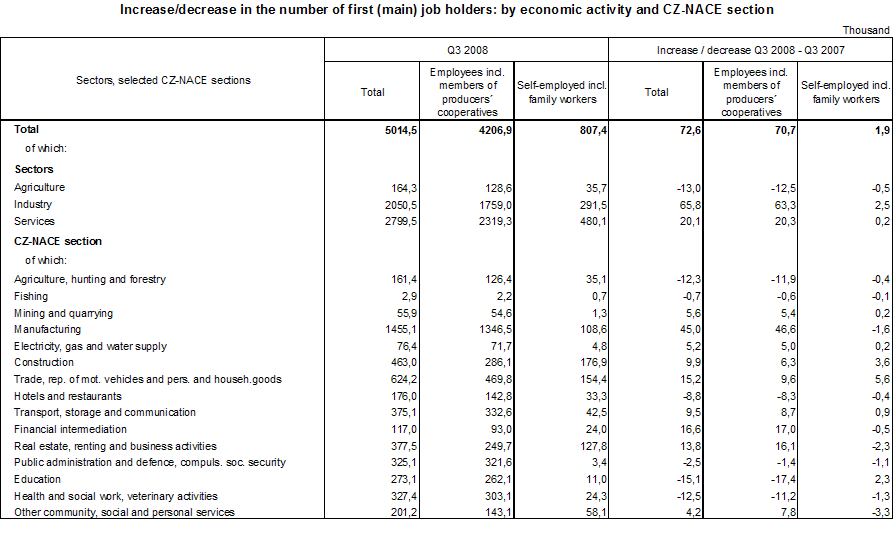
Employment increase was recorded only among people with higher levels of education. While the number of employed persons with basic education dropped by 6.4 thousand and the largest group of those with secondary education without maturita examination (mostly secondary vocational school graduates) decreased by 1.1 thousand, the number of employed persons with maturita examination rose by 26.4 thousand and employed university graduates grew by 54.1 thousand. We should note in this context that a large part of jobs where basic or lower secondary education is required is filled by foreigners who mostly do not live in dwellings and are not covered by the LFSS (see footnote 1).
The total employment rate among persons aged 15-64 grew by 0.4 percentage points year-on-year to 66.7%. The relative employment increase of men at working age was 0.4 percentage points and employment rate grew to 75.6%; the respective figures for females are 0.3 percentage points and 57.6%. The employment rate is pushed down by rapidly growing numbers of university students on the one hand, on the other the number of persons in employment is increasing due to the concurrence of employment in the strong birth cohorts from around 1950 and the mid-1970’s and the rising retirement age.
Concrete aims for the employment rate in the EU countries until 2010 were determined in the meetings of the European Council in Lisbon in 2000 and Stockholm in 2001. The total employment rate should reach at least 70%, female employment rate at least 60% and elderly employment rate (age group 55-64) at least 50%.
Compared internationally, the Czech Republic is among the EU countries with above-the-average employment intensity. According to the latest complete data for Q2 2008 released by Eurostat, the employment rate of persons aged 15-64 in the Czech Republic was higher than the total for the EU27. However, female employment rate in the Czech Republic is still lower than the EU27 average.
Differences in employment rates between EU countries are considerable, not only if we compare the whole age group 15-64, but also in the male and female employment components. On the one hand there is a high employment rate in the northern countries and the United Kingdom (e.g. in Denmark 78.4% in Q2 2008), on the other hand employment rate in some countries was below 60% (in Hungary 56.5% in Q2 2008). Compared to our neighbouring countries, higher employment rates are in Austria and Germany and significantly lower in Poland and Slovakia.
Even bigger differences are in the employment rate of persons aged 55-64. In Malta, Poland, Slovenia and Hungary, for example, it was just above 30%. A significant number of member states will have difficulty fulfilling the Lisbon strategy. Twelve member states have already exceeded the required 50% rate; all the northern and Baltic countries are among them.
Reaching at least 50% employment rate among people aged 55-64 will be complicated for the Czech Republic owing to a lower female employment rate. The employment rate of women aged 55-64 is still below the EU15 and below the EU27 average. It is, however, assumable that in the years to come the employment rate in the age group 55-64 will rise especially as a consequence of adjusting the retirement age. This is borne out by an increase in the employment rate of men aged 55-64 in the Czech Republic by 1.6 percentage points in the last year; employment rate of women aged 55-64 rose by 0.5 p.p. year-on-year.
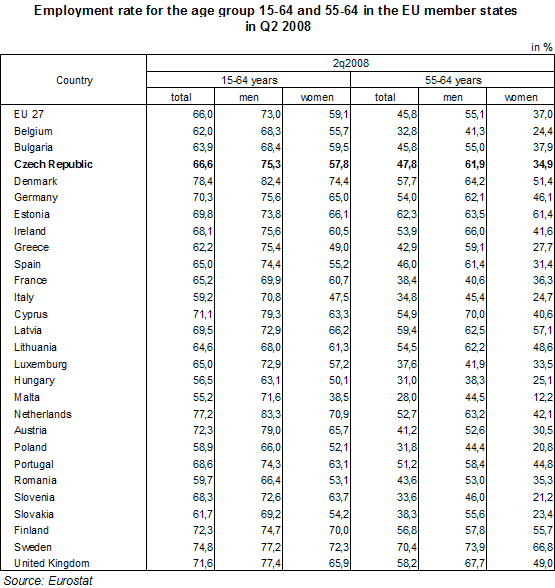
A high employment share of the secondary sector (industry + construction) is typical for the Czech economy. This share is second to none in the EU27 and only Slovakia is close to it. The same holds for manufacturing whose employment share was 29.0% in the Czech Republic in Q4 2007. Manufacturing’s employment share in the Czech Republic was nearly eleven points above the EU27 average and twelve points above the EU15 average. In contrast, employment share of service sector is significantly lower in the Czech Republic in comparison to the EU15 (-14.5 p.p.) and the EU27 alike (-11 p.p.). Below-the-average employment shares are recorded especially in the sections ‘health and social work’ and ‘real estate, renting and business activities’.
In terms of classification of economic activities, the differences between EU member states are extraordinarily high. In the Czech Republic, for example, employment in ‘manufacturing’ is four times higher than employment in ‘health and social work’, but the situation in many countries, especially the northern ones, is quite different. In four countries ‘health and social work’ employed more people than ‘manufacturing’ (in Sweden, Denmark, the Netherlands and Luxembourg).
The comparability of employment shares between EU countries in 2008 is rather complicated due to the introduction of the NACE Rev. 2 classification, which replaces NACE Rev. 1.1. Many of the EU countries have not available data according to NACE Rev. 1.1 and changes in employment structure in the Czech Republic are not directly comparable with the EU27 total. Despite that, the table below shows data for Q2 2008 documenting considerable differences in employment shares between EU countries. These differences are causing problems to be dealt with in the next years.
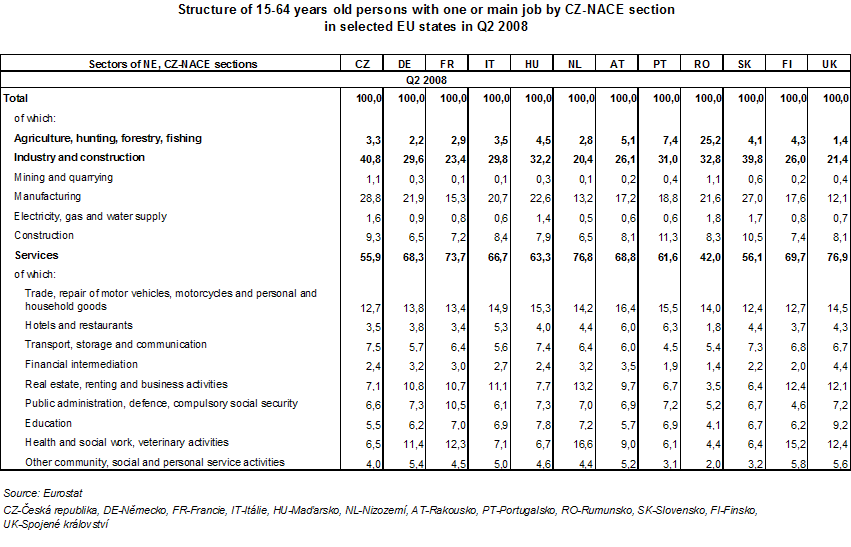
The Czech Republic belongs to the countries with a high self-employment share. In Q2 2008 the percentage of employers and own-account workers (excl. family workers) reached 15.5% of all one (main) job holders, while the EU27 average was 14.9% and the EU15 average 14.4%. Higher self-employment shares were observed in five Mediterranean countries, including Portugal, in which individual business in agriculture and tourism-related activities (retail trade, real estate and renting) plays an important role, and in Ireland. One of the highest self-employment shares in the long term is recorded in Romania (21.2%) and Poland (19.3%), as a result of especially high self-employment shares of agriculture. In the neighbouring countries, except Poland, the self-employment shares (excl. family workers) are considerably lower compared to the Czech Republic. In Q2 2008 they were 10.6% in Germany, 11.5% in Austria and 13.4% in Slovakia, i.e. 2–5 p.p. below the Czech Republic.
The effect of family workers on total employment is very limited. In Q2 2008 they made up 1.7% of all employed persons in the EU27, 1.0% in the EU15 and 0.5% in the Czech Republic. Quite a different situation is in Romania where family workers accounted for 12.5% of all main job holders and the self-employment share in Romania, like in Greece, exceeded a third of total employment.
The regional employment in the Czech Republic increased year-on-year in all the regions, except for the Zlínský, Jihočeský and Olomoucký Regions; the highest increases were recorded in the Středočeský, Moravskoslezský and Ústecký Regions. A marked increase was observed in the Plzeňský Region.
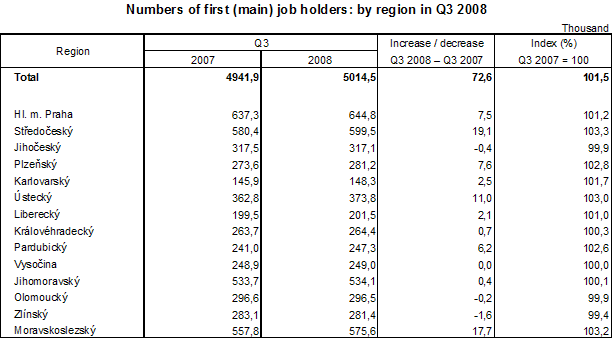
There were 95.2% (4 755.4 thousand) of persons working full time in their main job in the civil sector of the national economy. In total 242.1 thousand persons worked part-time in their main job, most of them were women (178.7 thousand).
The share of persons working full time in their main job in the Czech Republic is the fourth highest among the EU27 member states. The proportion of full-time jobs is higher in Slovakia, Hungary and Bulgaria, but the total employment rate is below the average in all of the three countries. The share of men working full time in the Czech Republic was the second highest among the EU27 countries in Q2 2008; women had the fifth highest share.
Especially women appear to have an extraordinary high differentiation of the share of full-time jobs in total employment in individual EU countries. In many countries of the EU15 high numbers of women use the opportunity to work part time, particularly in the Netherlands (3/4 of working women aged 15-64 years!), and in other five countries their share exceeded 40% of the total female employment. The opportunity to work part time is one of the social aspects which in the long term affects the fertility rate and the length of active working life in particular in the Netherlands and in some other countries. Just the frequent use of part-time work considerably increases the working activity of people at around sixty years of age.
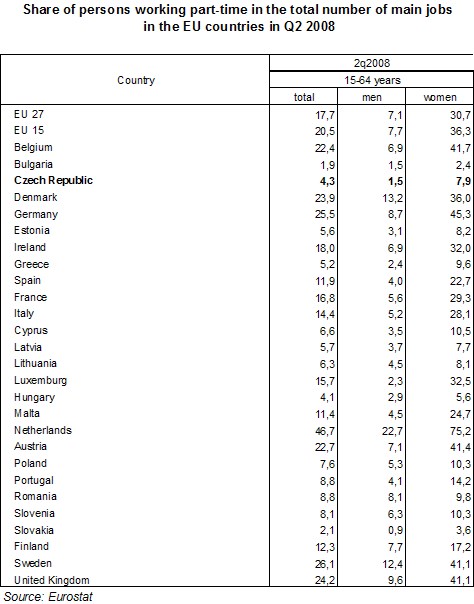
The average number of hours actually worked in the reference week reached 36.5, in full-time employment it was 37.4 hours. Lower number of hours worked in comparison to the previous quarters is due to a seasonal effect of holiday taking in the summer months. The differences in working hours of employees are large, both in terms of their professional status and CZ-NACE activity. The self-employed worked 45.8 hours a week on average, full-time employees 35.8 hours and members of producer cooperatives 38.2 hours. In the long term, these differences are apparent both for men and women when generally men work more hours in all of the professional status categories. The most hours in main job were spent by employees in construction (42.3 hours), the least by employees in education (21.4 hours).

Under growing total employment of the resident population and the economically inactive, the number of the unemployed decreased. The number of unemployed persons (ILO methodology) reached 224.5 thousand on average in Q3 2008, i.e. down by 42.2 thousand year-on-year (by nearly 16%). The number of the unemployed decreased in all the five-year groups of working age, the most in the age groups 25-29 (by 8.0 thousand), 40-44 (by 7.5 thousand) and 50-54 (by 9.6 thousand). The number of unemployed men (97.7 thousand in total) is still below the number of unemployed women (126.8 thousand). Under the total year-on-year fall in unemployment, male unemployment decreased by 22.1 thousand and female unemployment fell by 20.2 thousand.
The number of the long-term unemployed (1 year and more) fell by 25.0 thousand in total (by nearly a fifth); this fall was relatively more rapid than the rate of total unemployment decrease.
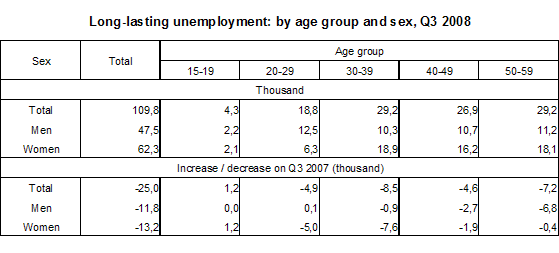
The number of the unemployed with basic education decreased by 5.9% year-on-year to 65.0 thousand, which is connected with a general decrease in the number of Czech residents at working age with the lowest level of education. The number of unemployed persons with secondary education without maturita examination (mostly secondary vocational school graduates) decreased by 26.0% to 89.4 thousand and the number of the unemployed with secondary education with maturita examination decreased by 12.9% to 53.5 thousand. The number of unemployed university graduates rose by 7.1% to 16.5 thousand but the unemployment rate of university graduates is constantly markedly lower if compared to the three above groups.
Unemployment dropped in all of the regions of the country, most in the Ústecký Region where the unemployment rate is below that in the Karlovarský Region.
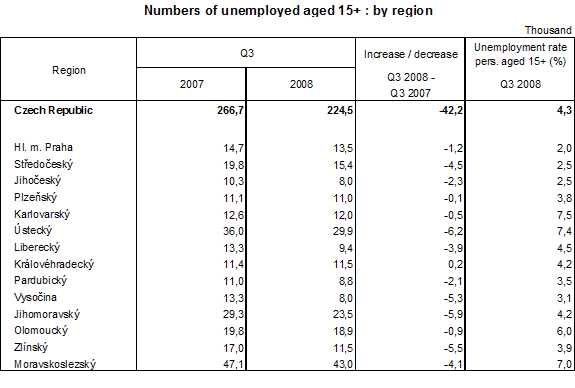
The growth of total employment and the decrease in the number of the unemployed resulted in a relatively high decrease in the general unemployment rate of persons aged 15-64 (ILO). In comparison to Q3 2007, the general unemployment rate decreased by 0.8 percentage points to 4.3%. It decreased among both the female (by 0.9 p.p. to 5.6%) and male population (by 0.8 p.p. to 3.3%).
According to the latest data released by Eurostat for Q2 2008, the general unemployment rate in the Czech Republic was markedly lower than in the EU27; besides the relatively low male unemployment rate, also the female unemployment rate was below the EU27 average. The big fall of unemployment in the Czech Republic showed itself in favourable comparison with the EU27 and the EU15 alike; in Q2 2008 the unemployment rate in the CR was by 2.7 percentage points below the EU15 average.
In comparison to the neighbouring countries, the rate of unemployment in the CR is higher than in Austria but markedly lower than in Slovakia where it is among the highest across the European Union. Also Poland reports markedly higher unemployment, although it decreased considerably year-on-year. The unemployment rate in the Czech Republic is noticeably lower also in comparison with Germany, mainly due to the long-term unfavourable situation in the new federal states.
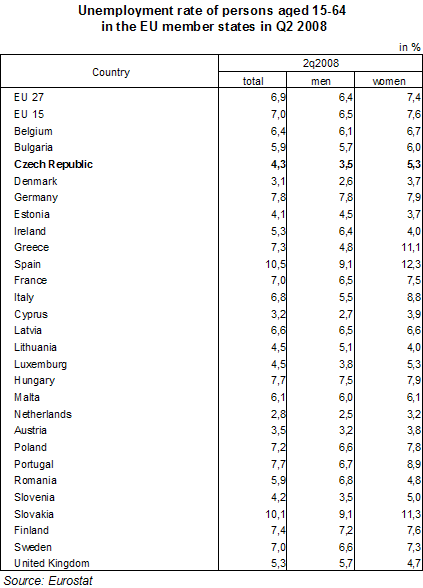
Compared to other countries, an unfavourable aspect of unemployment in the Czech Republic is the persistent high percentage of the long-term unemployed. The proportion of persons out of work for one year and more in the total number of the unemployed was the fourth highest among all the EU countries in Q2 2008 (51.2% in the CR in comparison to 38.5% in the EU27 and 37.5% in the EU15). The highest proportions of the long-term unemployed were observed, besides Belgium, in neighbouring Germany and especially Slovakia where it exceeded three quarters of the total unemployed.
The high percentage of long-term unemployment in the above countries represents a chronic problem relating not only to the elderly unemployed.
The number of economically inactive persons aged 15 and over (according to the LFSS methodology they are persons who had no job and were not seeking a job during last four weeks or did not meet all the conditions for being classified as unemployed) increased by 69.0 thousand year-on-year and reached 3 713.9 thousand in Q3 2008. This category is primarily affected by numbers of the retired and of persons in schooling or training for their future occupation. The number of basic school pupils slightly increased by 0.4 thousand to 76.1 thousand and the number of secondary school pupils including vocational school pupils decreased by 5.0 thousand to 519.5 thousand. The number of university students including higher professional school students grew markedly by 19.0 thousand to 311.4 thousand. The number of non-working normally retired persons not actively seeking job reached 1 945.7 thousand, the number of early retired persons 44.6 thousand and the number of disability pensioners 267.4 thousand. These figures cannot accurately correspond to the numbers of pupils and students according to the statistics of the Ministry of Education, Youth and Sports of the CR or to the numbers of pensioners on the records of the Ministry of Labour and Social Affairs of the CR because the pupils, students or pensioners who fulfilled the criterion of being classified among persons in employment or unemployed persons in the reference week are not recorded as economically inactive.
_______________________
1 Note: When assessing the distribution of persons in employment by NACE activity, we should take into account the methodology of the LFSS which is carried out only in households and not in collective accommodation establishments. The data on numbers of employed persons from the LFSS are then statistically corrected to be in harmony with data on employment of foreigners in a given NACE activity. According to available data from the Ministry of Labour and Social Affairs and the Ministry of Industry and Trade, the numbers of foreigners working in ‘manufacturing’, ‘construction’, ‘wholesale and retail trade; repair of motor vehicles, motorcycles and personal and household goods’, ‘real estate, renting and business activities’ are on the rapid increase; an overwhelming majority of these foreigners do not live in households.
